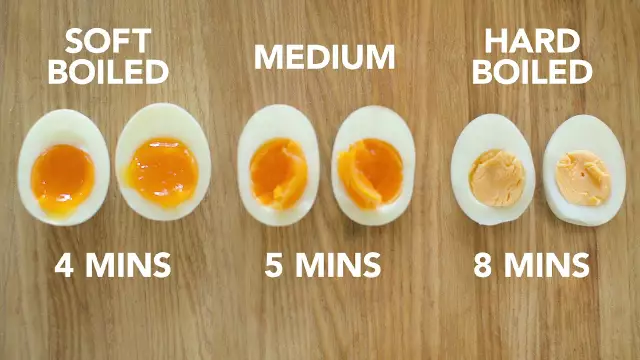- Author Rachel Wainwright [email protected].
- Public 2023-12-15 07:39.
- Last modified 2025-11-02 20:14.
Calorie content of the tongue

Tongue is a meat delicacy used to prepare various dishes, as well as consumed in its pure form. Due to the beneficial properties, nutritional value of the tongue, calorie content, this delicacy belongs to the first category by-products. Beef tongue, the calorie content of which is extremely low with a high nutritional value, is a dietary product that can be supplemented with any low-calorie diet. How many calories are in a language? How to cook a boiled tongue, the calorie content of which will remain low?
Language: calorie content, nutritional value, useful properties of the tongue
Tongue (beef and pork) belongs to the first category by-products. By-products of the first category also include liver, heart, kidneys, brains, udders, as well as beef and lamb meat and bone tails. The tongue, the calorie content of which remains at an extremely low level with a high nutritional value, is a solid muscle tissue covered with an outer rough shell. There is practically no connective tissue in the pulp of the tongue, which contributes to its easy absorption by the body.
The tongue, the calorie content of which depends on the methods of its preparation, is sold fresh, frozen, smoked, and also in the form of ready-made cold snacks. Boiled beef tongue is the least high-calorie and most useful, while smoked tongue (both beef and pork) and tongue snacks have the highest calories.
The pulp of the tongue, the calorie content of which allows this delicacy to be consumed during the diet, contains vitamins of group B, as well as vitamins E and PP. The pulp of the tongue contains iron, phosphorus, potassium, magnesium, manganese, sodium and other nutrients that the body needs for normal functioning.
Beef tongue: calorie content, useful properties
The pulp of beef tongue, the calorie content of which reaches 177 calories per 100 g of product, contains:
- Protein - 16 g;
- Fat - 12 g;
- Carbohydrates - 2.2 g.
Beef tongue, the calorie content of which remains at a fairly low level with various cooking methods, is an excellent addition to both the daily diet and dietary nutrition. Beef tongue is recommended to be introduced into the BUCH diet (protein-carbohydrate alternation), due to the high level of protein fibers. The tongue promotes long-term satiety.
Beef tongue is recommended to be introduced into the diet for pregnant women, children, patients suffering from anemia (due to the high iron content), as well as patients with diseases of the gastrointestinal tract, cardiovascular system. Beef tongue is a great alternative to other meats during the diet.
The mass of the beef tongue ranges from 1 to 2.5 kg. 100 g of beef tongue contains 9% of the daily intake of calories, covers the daily intake of vitamin B12, which regulates fat and carbohydrate metabolism in the body, as well as up to 40% of the daily intake of zinc, which helps lower cholesterol levels in the body.
The tongue, the calorie content of which is extremely low in comparison with its nutritional value, has excellent taste in comparison with lamb or pork tongue.
Pork tongue: calorie content, useful properties
Pork tongue, the calorie content of which is slightly higher than that of beef tongue, also belongs to the first category by-products. The pork tongue in its nutritional value is somewhat inferior to the beef tongue.
The ratio of nutrients in pork tongue, the calorie content of which reaches 208 calories per 100 g, is:
- Proteins - 15.9 g;
- Fat - 16 g;
- Carbohydrates - 2.1 g.

Pork tongue, the calorie content of which is lower than the calorie content of other offal, has the following beneficial properties:
- Improving metabolism;
- Strengthening bone and muscle tissues of the body;
- Normalization of the function of the cardiovascular system;
- Removal of cholesterol from the body;
- Normalization of the nervous system;
- Long-term feeling of satiety.
The weight of one pork tongue ranges from 250 g to 450 g. The predominant method of preparing a pork tongue, the calorie content of which will remain at a low level, is boiling.
Tongue cooking methods: how many calories are in the language?
With different methods of preparing the tongue, the calorie content of this delicacy will change. So, the tongue can be prepared independently by buying a fresh or frozen product, or you can give preference to ready-made varieties of the tongue, the calorie content of which is much higher. Useful properties of boiled tongue, calorie content will also depend on the type of livestock. So, the calorie content of boiled beef tongue will be lower than that of boiled pork tongue. The calorie content of the tongue will depend on the dish in which the tongue is included (salads seasoned with mayonnaise), or on the way it is prepared.
The tongue is mainly boiled. The correct way to prepare it is preliminary cleaning of fat, connective tissue, larynx, boiling it in a sufficient amount of water for 2.5-3 hours. Then the tongue must be cleaned of the tough skin. To do this, it is necessary to place the newly boiled tongue in cold water for 3-5 minutes, after which the tough skin will be removed much easier.
Boiled tongue, the calorie content of which is low, is used both independently and as part of other dishes: jellied tongue, salads, tongue rolls, cold cuts.
The tongue is not recommended to be fried or baked in the oven (which will significantly increase its calorie content, since it requires the addition of fats), since this product requires long-term heat treatment for full readiness. When low in calories, the tongue has a delicate taste and excellent nutritional properties.
Language and diet: is it possible to use offal in the diet
There is an opinion that by-products are not particularly useful for the body. According to nutritionists, some offal are irreplaceable sources of vitamins and elements and are used in therapeutic diets. Many by-products have a fairly low calorie content with a high nutritional value. Considering how many calories are in the language, this delicacy can be attributed to dietary products. When compiling a diet, it is necessary to take into account the calories of the tongue and the way it is prepared.
For a dietary diet, it is best to choose either fresh or frozen food, avoiding ready-to-eat delicacies. Boiled tongue is a useful dietary ingredient. It is an indispensable source of protein that provides long-lasting satiety so that you can effectively deal with hunger without unnecessary snacks.
Also, the language, the calorie content of which allows you to safely include it in the diet, provides the body with the necessary vitamins and microelements. The tongue will also allow you to diversify your diet, eating tasty and healthy.
When following a diet, remember that effective weight loss requires an integrated approach to diet and lifestyle. Moderate food intake, an active lifestyle and proper nutrition after leaving the diet will quickly cope with excess weight.
Found a mistake in the text? Select it and press Ctrl + Enter.






